Influence of Processing Parameters on the Conduct of Electrical Resistance Sintering of Iron Powders
Abstract
1. Introduction
2. Experimental Procedure and Materials
2.1. MF-ERS Equipment and Process
2.2. Material and Characterisation
3. Results and Discussion
3.1. Effect of Processing Parameters on Porosity
3.2. Relationship between Specific Thermal Energy and Porosity
3.3. Porosity Distribution inside the Compacts
3.4. Microhardness
4. Conclusions
Author Contributions
Funding
Acknowledgments
Conflicts of Interest
References
- Lux, J. Improved Manufacture of Electric Incandescence Lamp Filaments from Tungsten or Molybdenum or an Alloy thereof. GB Patent 1906, 27, 13. [Google Scholar]
- Taylor, G.F. Apparatus for Making Hard Metal Compositions. U.S. Patent 1,896,854, 7 February 1933. [Google Scholar]
- Lenel, F.V. Resistance Sintering Under Pressure. JOM 1955, 7, 158–167. [Google Scholar] [CrossRef]
- Istomina, T.I.; Baidenko, A.A.; Raichenko, A.I.; Goldberg, M.A.; Svechkov, A.V. Influence of premolding pressure in electric-discharge sintering on the physicomechanical properties of a copper-tin-abrasive composite. Sov. Powder Metal. Met. Ceram. 1983, 22, 957–960. [Google Scholar] [CrossRef]
- Burenkov, G.L.; Raichenko, A.I.; Suraeva, M. Dynamics of interparticle reactions in spherical metal powders during electric sintering. Sov. Powder Metall. Met. Ceram. 1987, 26, 709–712. [Google Scholar] [CrossRef]
- Sukhov, O.V.; Baidenko, A.A.; Istomina, T.I.; Raichenko, A.I.; Popov, V.P.; Svechkov, A.V.; Goldberg, M.A. Densification kinetics of a copper-tin powder composite during electric-discharge sintering. Sov. Powder Metall. Met. Ceram. 1987, 26, 530–532. [Google Scholar] [CrossRef]
- Akechi, K.; Hara, Z. Analysis of electric resistance-sintering process of titanium powders. J. Jpn. Soc. Powder Powder Metall. 1978, 25, 193–197. [Google Scholar] [CrossRef]
- Suzuki, T.; Saito, S. Study on spark sintering method with nickel powder. J. Jpn. Soc. Powders Powder Metall. 1971, 18, 28–33. [Google Scholar] [CrossRef]
- Saito, S.; Ishiyama, T.; Sawaoka, A. Sinterability of aluminum powder activated by flash electric discharge. Bull. Tokyo Inst. Tech. 1974, 120, 137–142. [Google Scholar]
- Hong, J.; Kao, P.W. SiC-reinforced aluminium composite made by resistance sintering of mechanically alloyed powders. Mater. Sci. Eng. A 1989, 119, 153–159. [Google Scholar] [CrossRef]
- Okazaki, K. Electro-discharge consolidation of particulate materials. Rev. Part. Mater. 1994, 2, 215–269. [Google Scholar]
- Grasso, S.; Sakka, Y.; Maizza, G. Electric current activated/assisted sintering (ECAS): A review of patents 1906–2008. Sci. Technol. Adv. Mater. 2009, 10, 053001. [Google Scholar] [CrossRef] [PubMed]
- Orrù, R.; Licheri, R.; Locci, A.M.; Cincotti, A.; Cao, G. Consolidation/synthesis of materials by electric current activated/assisted sintering. Mat. Sci. Eng. R Rep. 2009, 63, 127–287. [Google Scholar] [CrossRef]
- Olevsky, E.A.; Dudina, D.V. Field-Assisted Sintering Science and Applications, 1st ed.; Springer International Publishing: Cham, Switzerland, 2018. [Google Scholar]
- Fais, A. A Faster FAST: Electro-Sinter-Forging. Metal Powder Rep. 2018, 73, 80–86. [Google Scholar] [CrossRef]
- Cannella, E.; Nielsen, C.V.; Bay, N. Process Investigation and Mechanical Properties of Electro Sinter Forged (ESF) Titanium Discs. Int. J. Adv. Manuf. Technol. 2019, 104, 1985–1998. [Google Scholar] [CrossRef]
- Brisson, E.; Carre, P.; Desplats, H.; Rogeon, P.; Keryvin, V.; Bonhomme, A. Effective Thermal and Electrical Conductivities of AgSnO2 During Sintering. Part I: Experimental Characterization and Mechanisms. Metall. Mater. Trans. A 2016, 47, 6304–6318. [Google Scholar]
- Anselmi-Tamburini, U.; Groza, J.R. Critical assessment: Electrical field/current application. A revolution in materials processing/sintering. Mater. Sci. Technol. 2017, 33, 1855–1862. [Google Scholar]
- Montes, J.M.; Cuevas, F.G.; Ternero, F.; Astacio, R.; Caballero, E.S.; Cintas, J. Medium-Frequency Electrical Resistance Sintering of Oxidized, C.P. Iron Powder. Metals 2018, 8, 426. [Google Scholar] [CrossRef]
- Montes, J.M.; Cuevas, F.G.; Cintas, J.; Urban, P. A One-Dimensional Model of the Electrical Resistance Sintering Process. Metall. Mater. Trans. A 2015, 46, 963–980. [Google Scholar] [CrossRef]
- Montes, J.M.; Cuevas, F.G.; Reina, F.J.V.; Ternero, F.; Astacio, R.; Caballero, E.S.; Cintas, J. Modelling and Simulation of the Electrical Resistance Sintering Process of Iron Powders. Metals Mater. Int. 2019, 1–15, Article in press. [Google Scholar] [CrossRef]
- Cuevas, F.G.; Andreouli, D.; Gallardo, J.M.; Oikonomou, V.; Cintas, J.; Torres, Y.; Montes, J.M. Ceramic dies selection for electrical resistance sintering of metallic materials. Ceram. Int. 2019, 45, 14555–14561. [Google Scholar] [CrossRef]
- Fais, A.; Actis Grande, M.; Forno, I. Influence of Processing Parameters on the Mechanical Properties of Electro-Sinter-Forged Iron Based Powders. Mater. Des. 2016, 93, 458–466. [Google Scholar] [CrossRef]
- MPIF Standard 46. Determination of tap density of metal powders. In Standard Test Methods for Metal Powders and Powder Metallurgy Products; Metal Powder Industries Federation (MPIF): Princeton, NJ, USA, 2016. [Google Scholar]
- MPIF Standard 4. Determination of Apparent Density of Free-Flowing Metal Powders Using the Hall Apparatus. In Standard Test Methods for Metal Powders and Powder Metallurgy Products; Metal Powder Industries Federation (MPIF): Princeton, NJ, USA, 2016. [Google Scholar]
- MPIF Standard 45. Method for Determination of Compressibility of Metal Powders. In Standard Test Methods for Metal Powders and Powder Metallurgy Products; Metal Powder Industries Federation (MPIF): Princeton, NJ, USA, 2016. [Google Scholar]
- ISO Standard ISO 6507-1:2018. Metallic Materials—Vickers Hardness Test—Part 1: Test Method; European Committee for Standardization (CEN): Brussels, Belgium, 2018. [Google Scholar]
- German, R.M. Powder Metallurgy & Particulate Materials Processing; Metal Powder Industries Federation (MPIF): Princeton, NJ, USA, 2005; p. 192. [Google Scholar]
- Brandes, E.A. Smithells Metals Reference Book, 6th ed.; Butterworths & Co Publishers: London, UK, 1983; Section. 25-1, Table 25.5. [Google Scholar]
- German, R.M. Sintering Theory and Practice, 1st ed.; John Wiley & Sons: Hoboken, NJ, USA, 1996. [Google Scholar]
- Powder Metallurgy. In Metals Handbook; ASM International: Novelty, OH, USA, 2015; Volume 7.
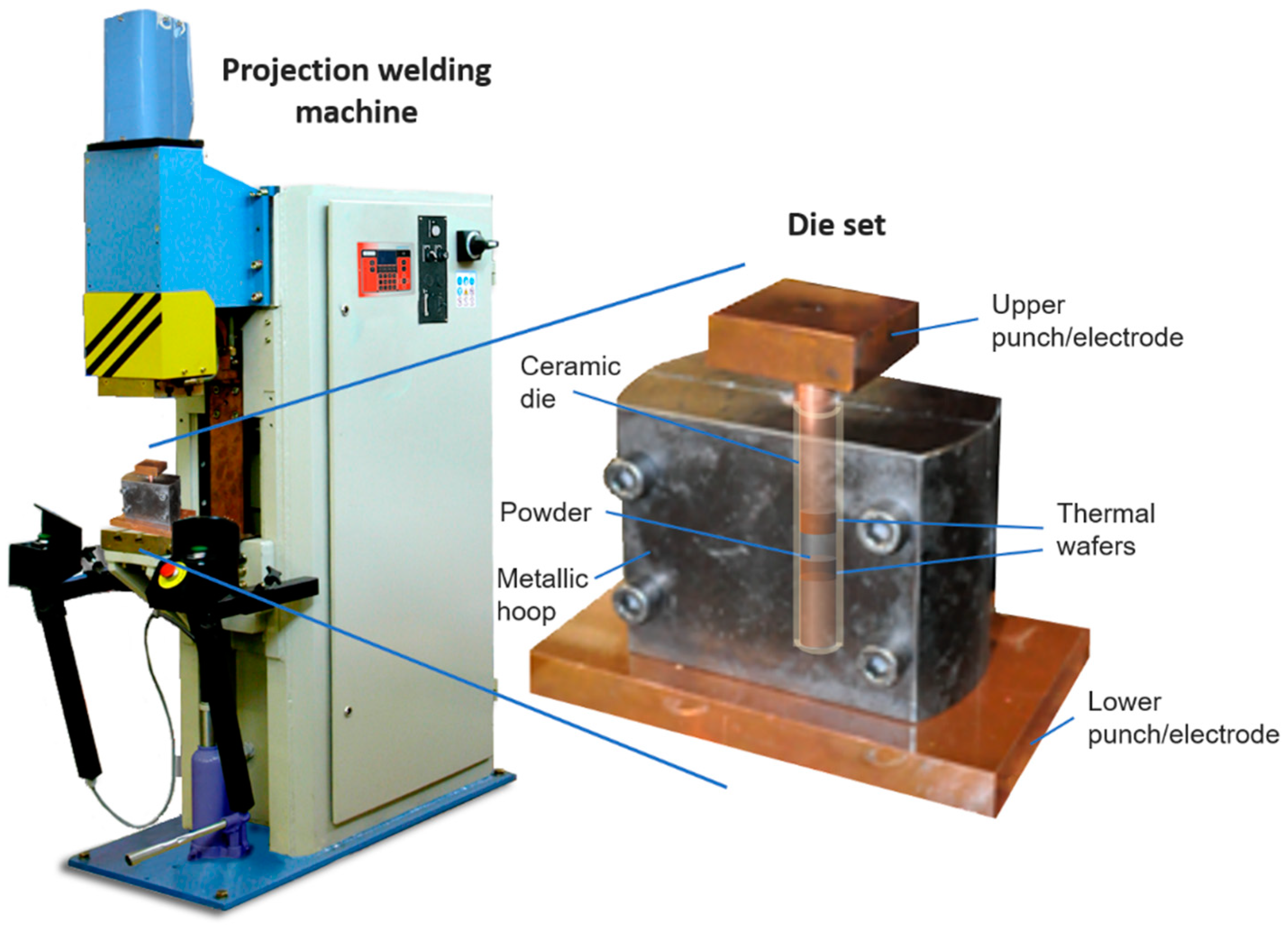
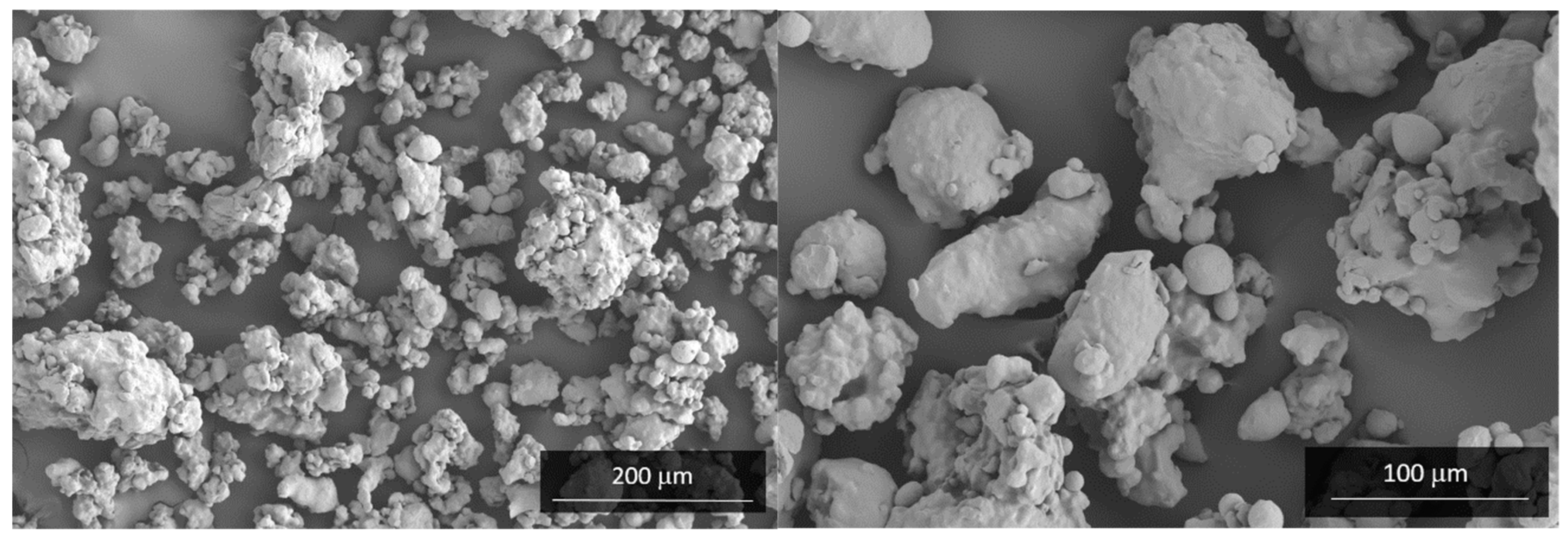
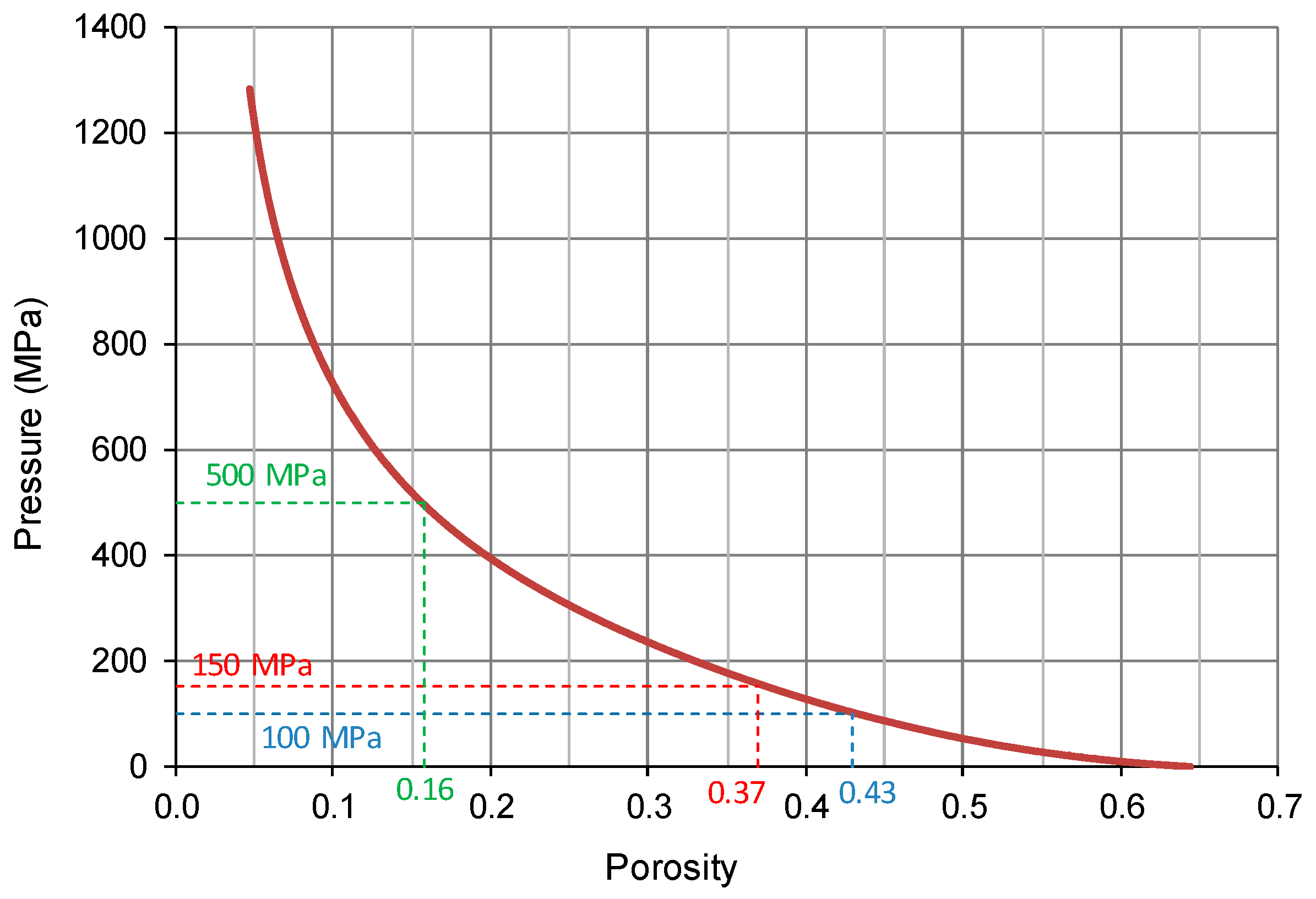
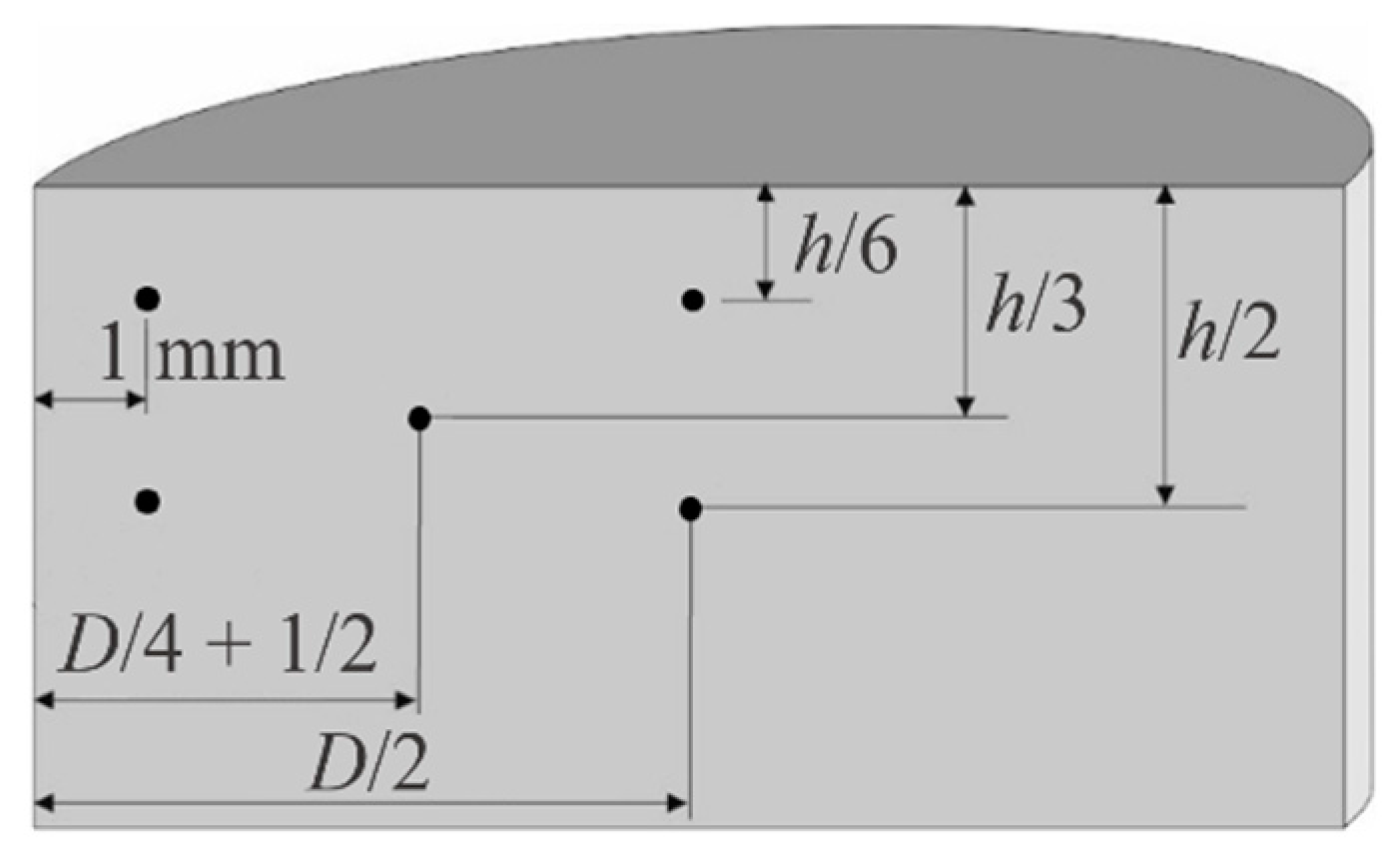
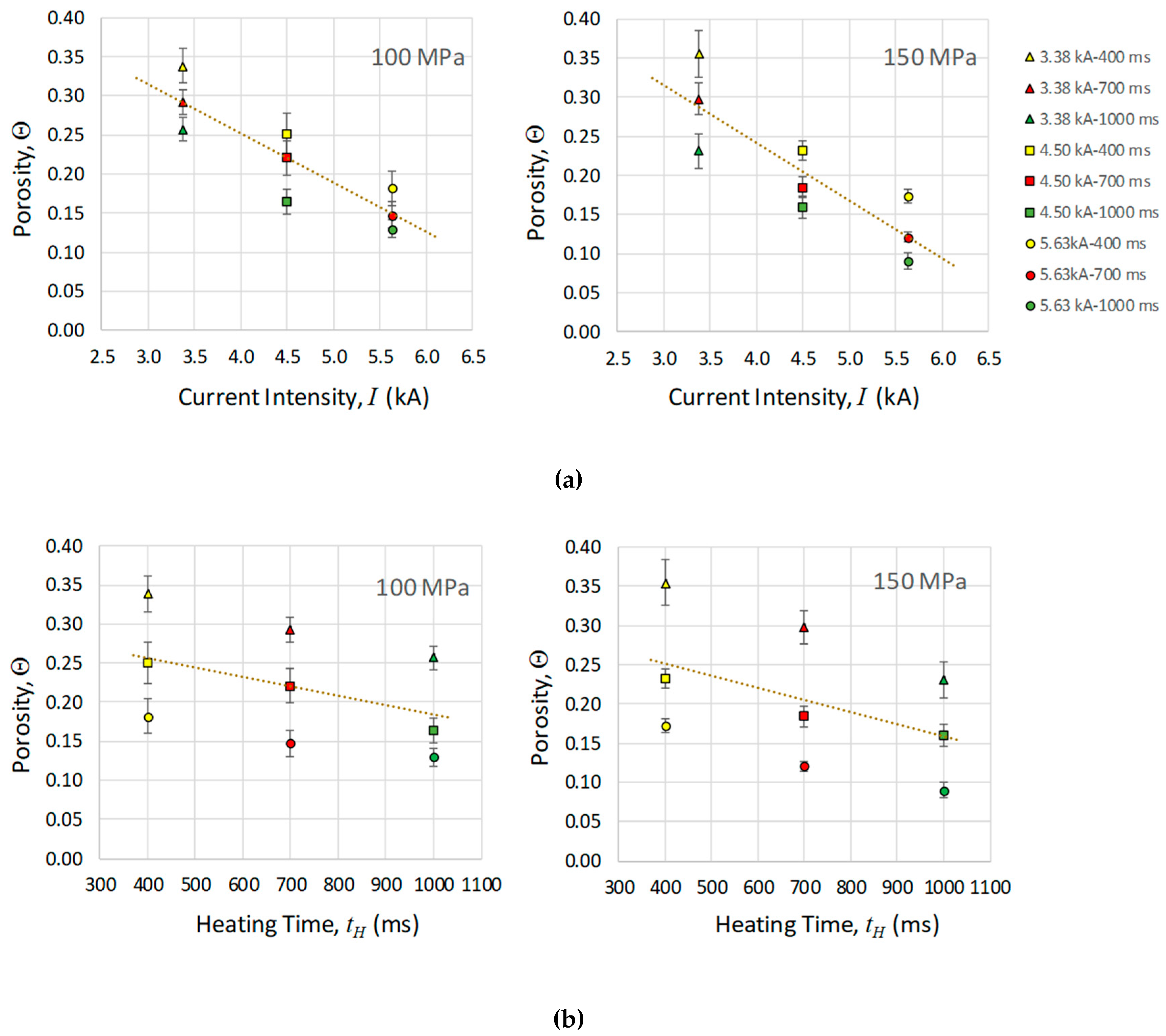
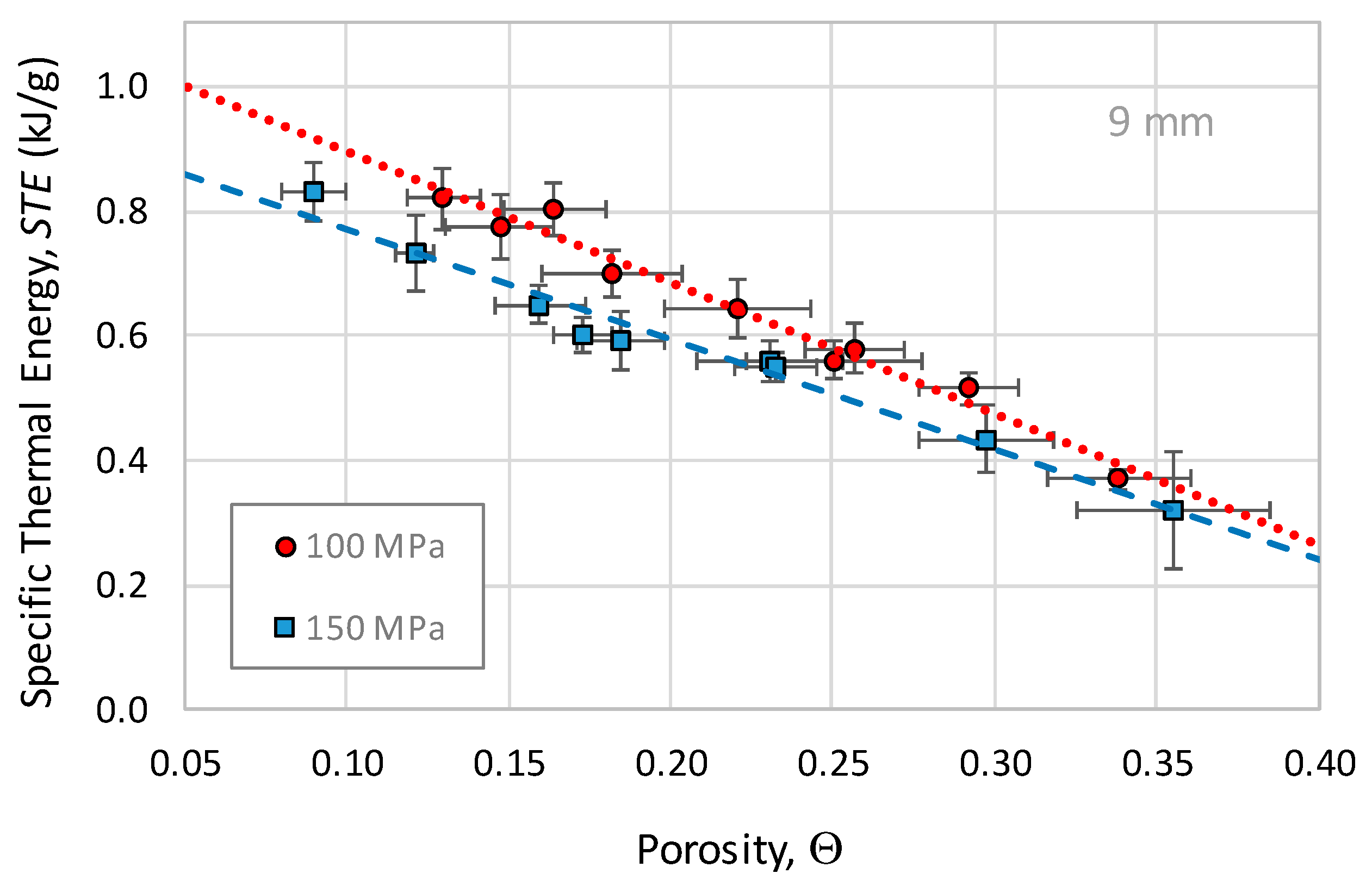
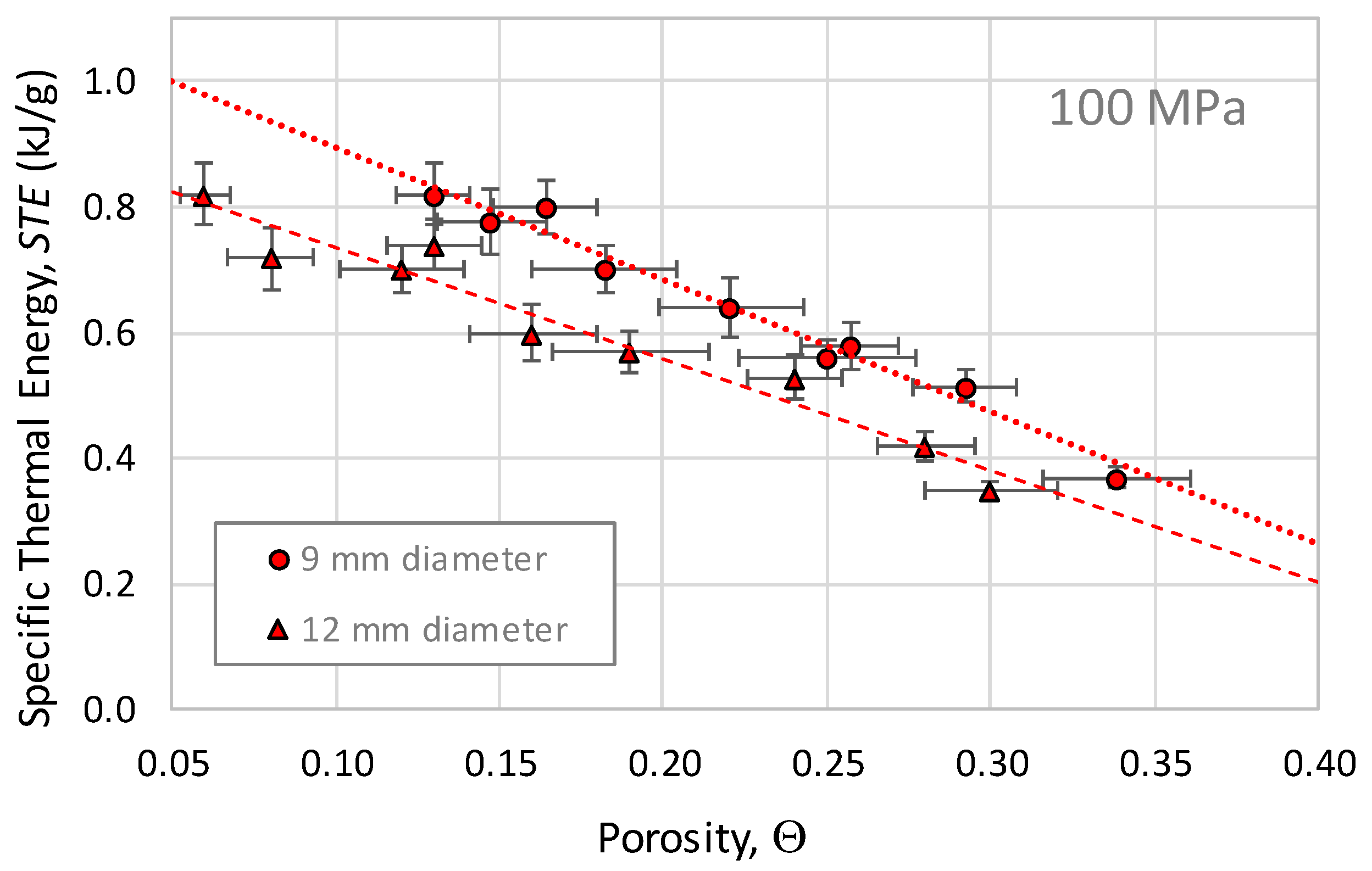
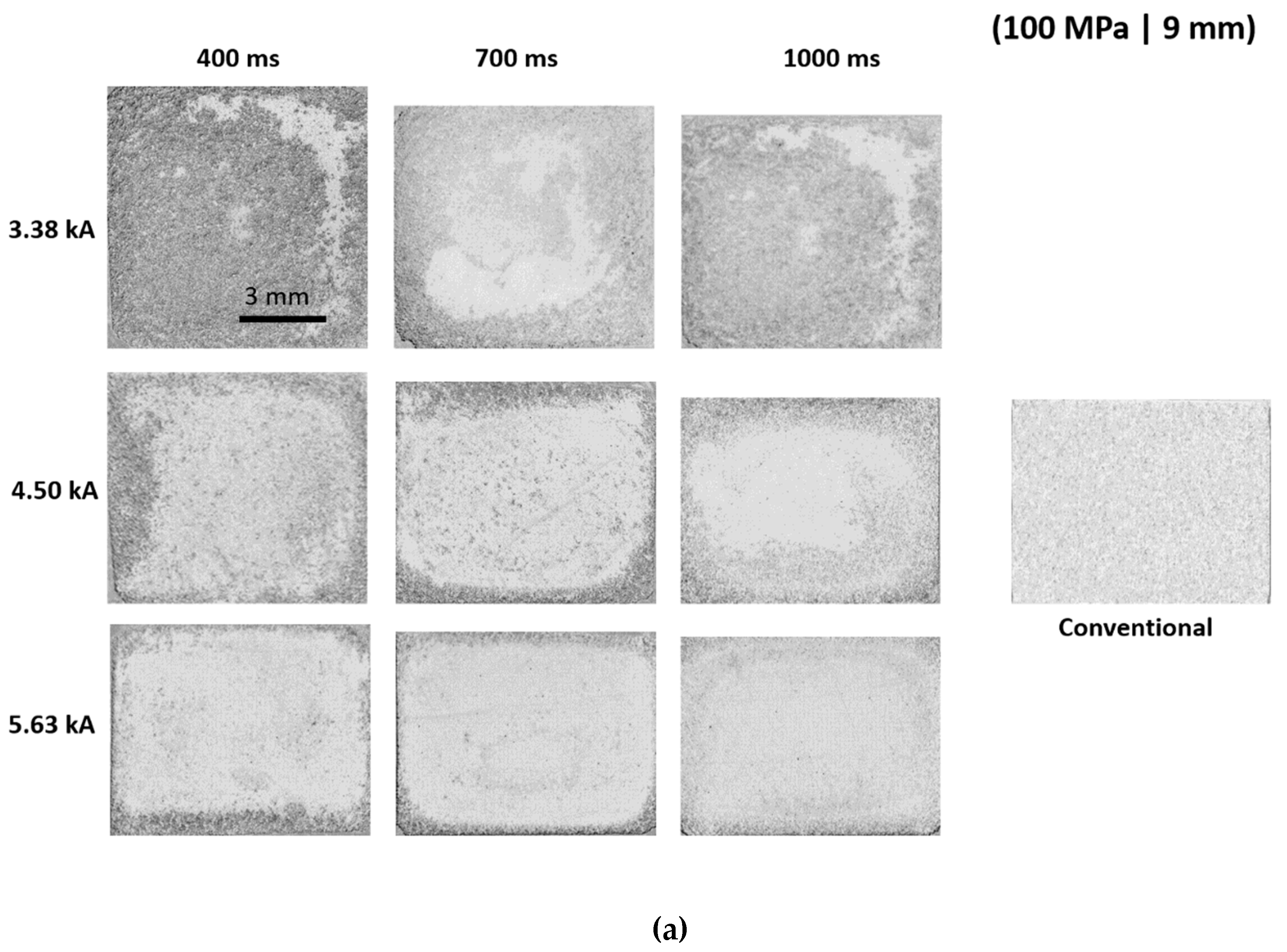
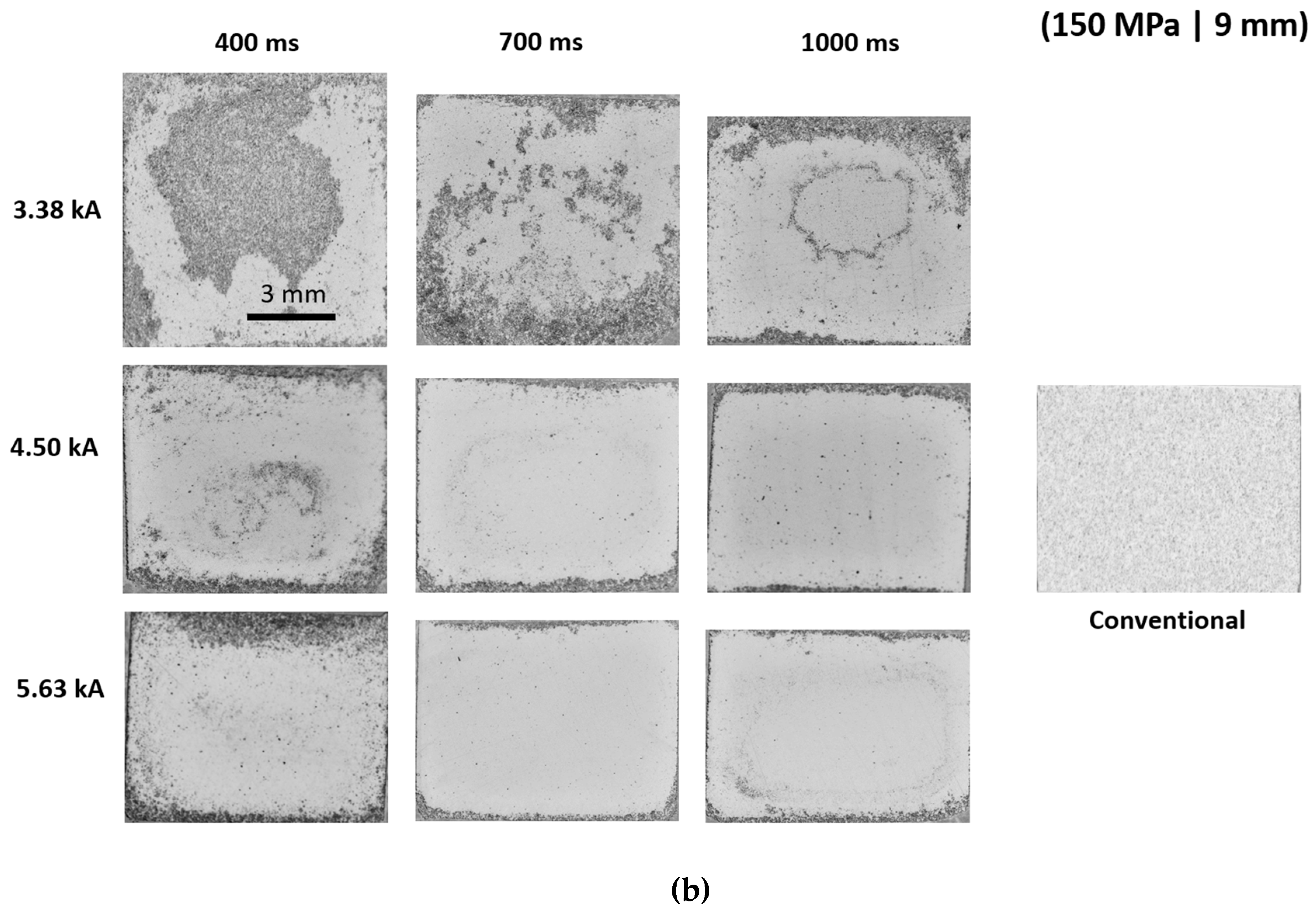
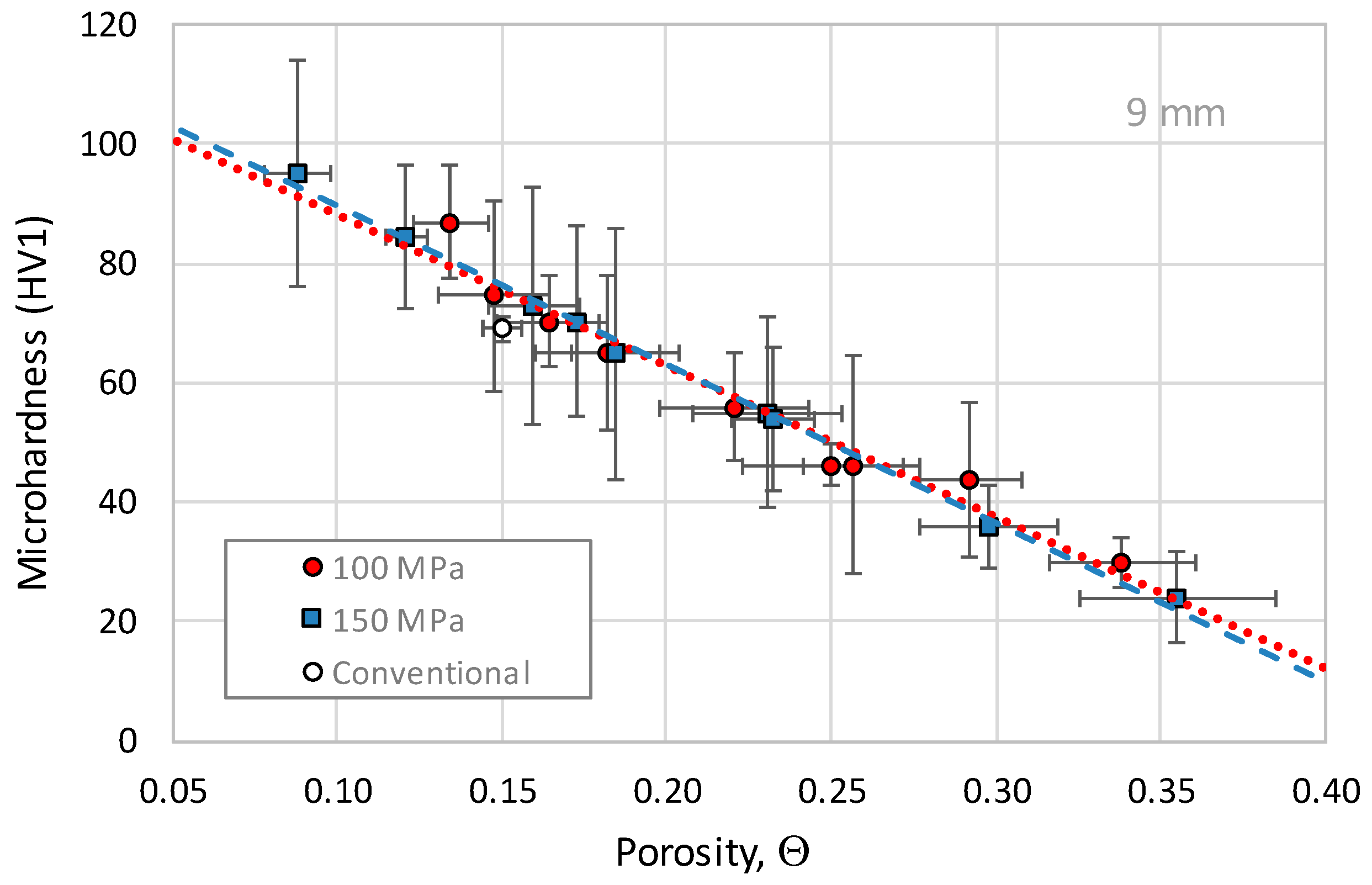
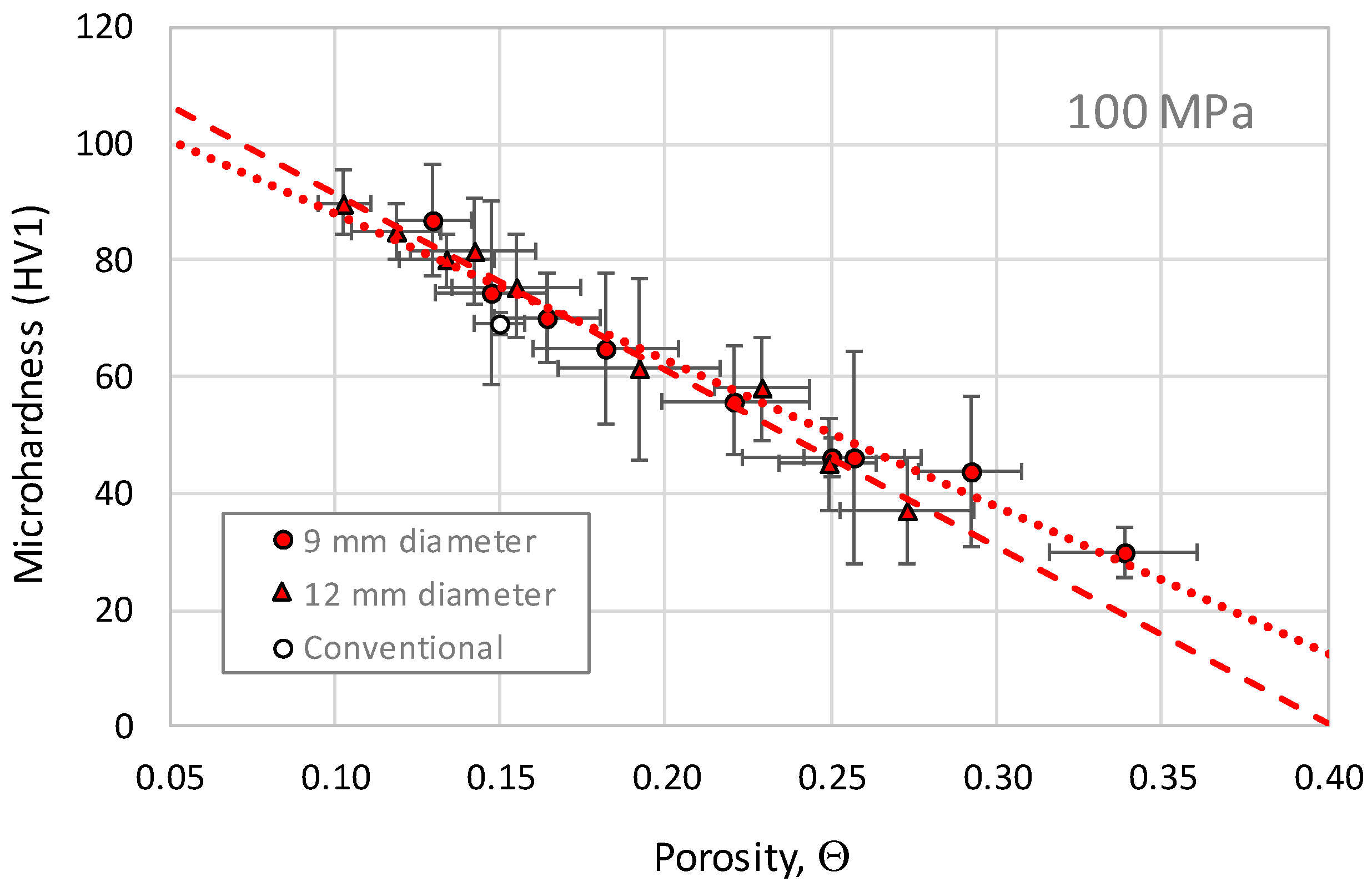
| Processing Conditions | Porosity, Θ | ||
|---|---|---|---|
| Intensity (kA) | Heating Time (ms) | Pressure (MPa) | |
| 100 | 150 | ||
| 3.38 | 400 | 0.34 | 0.36 |
| 700 | 0.29 | 0.30 | |
| 1000 | 0.26 | 0.23 | |
| 4.50 | 400 | 0.25 | 0.23 |
| 700 | 0.22 | 0.18 | |
| 1000 | 0.16 | 0.16 | |
| 5.63 | 400 | 0.18 | 0.17 |
| 700 | 0.15 | 0.12 | |
| 1000 | 0.13 | 0.09 | |
| Processing Conditions | Specific Thermal Energy, STE | ||
|---|---|---|---|
| Intensity (kA) | Heating Time (ms) | Pressure (MPa) | |
| 100 | 150 | ||
| 3.38 | 400 | 0.37 | 0.32 |
| 700 | 0.52 | 0.43 | |
| 1000 | 0.58 | 0.56 | |
| 4.50 | 400 | 0.56 | 0.55 |
| 700 | 0.64 | 0.59 | |
| 1000 | 0.80 | 0.65 | |
| 5.63 | 400 | 0.70 | 0.60 |
| 700 | 0.78 | 0.73 | |
| 1000 | 0.82 | 0.83 | |
| Processing Conditions | Microhardness, HV1 | ||
|---|---|---|---|
| Intensity (kA) | Heating Time (ms) | Pressure (MPa) | |
| 100 | 150 | ||
| 3.38 | 400 | 30 ± 4 | 24 ± 8 |
| 700 | 44 ± 13 | 36 ± 7 | |
| 1000 | 46 ± 18 | 55 ± 16 | |
| 4.50 | 400 | 46 ± 3 | 54 ± 12 |
| 700 | 56 ± 9 | 65 ± 21 | |
| 1000 | 70 ± 8 | 73 ± 20 | |
| 5.63 | 400 | 65 ± 13 | 70 ± 16 |
| 700 | 75 ± 16 | 85 ± 12 | |
| 1000 | 87 ± 10 | 95 ± 19 | |
© 2020 by the authors. Licensee MDPI, Basel, Switzerland. This article is an open access article distributed under the terms and conditions of the Creative Commons Attribution (CC BY) license (http://creativecommons.org/licenses/by/4.0/).
Share and Cite
Ternero, F.; Astacio, R.; Caballero, E.S.; Cuevas, F.G.; Montes, J.M. Influence of Processing Parameters on the Conduct of Electrical Resistance Sintering of Iron Powders. Metals 2020, 10, 540. https://doi.org/10.3390/met10040540
Ternero F, Astacio R, Caballero ES, Cuevas FG, Montes JM. Influence of Processing Parameters on the Conduct of Electrical Resistance Sintering of Iron Powders. Metals. 2020; 10(4):540. https://doi.org/10.3390/met10040540
Chicago/Turabian StyleTernero, Fátima, Raquel Astacio, Eduardo S. Caballero, Francisco G. Cuevas, and Juan M. Montes. 2020. "Influence of Processing Parameters on the Conduct of Electrical Resistance Sintering of Iron Powders" Metals 10, no. 4: 540. https://doi.org/10.3390/met10040540
APA StyleTernero, F., Astacio, R., Caballero, E. S., Cuevas, F. G., & Montes, J. M. (2020). Influence of Processing Parameters on the Conduct of Electrical Resistance Sintering of Iron Powders. Metals, 10(4), 540. https://doi.org/10.3390/met10040540








